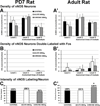Periaqueductal gray neuroplasticity following chronic morphine varies with age: role of oxidative stress
- PMID: 22999971
- PMCID: PMC3489988
- DOI: 10.1016/j.neuroscience.2012.09.028
Periaqueductal gray neuroplasticity following chronic morphine varies with age: role of oxidative stress
Abstract
The development of tolerance to the antinociceptive effects of morphine has been associated with networks within ventrolateral periaqueductal gray (vlPAG) and separately, nitric oxide signaling. Furthermore, it is known that the mechanisms that underlie tolerance differ with age. In this study, we used a rat model of antinociceptive tolerance to morphine at two ages, postnatal day (PD) 7 and adult, to determine if changes in the vlPAG related to nitric oxide signaling produced by chronic morphine exposure were age-dependent. Three pharmacological groups were analyzed: control, acute morphine, and chronic morphine group. Either morphine (10mg/kg) or equal volume of normal saline was given subcutaneously twice daily for 6½ days. Animals were analyzed for morphine dose-response using Hot Plate test. The expression of several genes associated with nitric oxide metabolism was evaluated using rtPCR. In addition, the effect of morphine exposure on immunohistochemistry for Fos, and nNOS as well as nicotinamide adenine dinucleotide phosphate diaphorase (NADPH-d) reaction at the vlPAG were measured. In both age groups acute morphine activated Fos in the vlPAG, and this effect was attenuated by chronic morphine, specifically in the vlPAG at the level of the laterodorsal tegmental nucleus (LDTg). In adults, but not PD7 rats, chronic morphine administration was associated with activation of nitric oxide function. In contrast, changes in the gene expression of PD7 rats suggested superoxide and peroxide metabolisms may be engaged. These data indicate that there is supraspinal neuroplasticity following morphine administration as early as PD7. Furthermore, oxidative stress pathways associated with chronic morphine exposure appear age-specific.
Copyright © 2012 IBRO. Published by Elsevier Ltd. All rights reserved.
Conflict of interest statement
There are no conflicts of interest.
Figures







Similar articles
-
Activation of P2X7 receptors in the midbrain periaqueductal gray of rats facilitates morphine tolerance.Pharmacol Biochem Behav. 2015 Aug;135:145-53. doi: 10.1016/j.pbb.2015.06.002. Epub 2015 Jun 6. Pharmacol Biochem Behav. 2015. PMID: 26054441
-
Chronic inflammatory pain prevents tolerance to the antinociceptive effect of morphine microinjected into the ventrolateral periaqueductal gray of the rat.J Pain. 2013 Dec;14(12):1601-10. doi: 10.1016/j.jpain.2013.08.003. Epub 2013 Oct 22. J Pain. 2013. PMID: 24161274 Free PMC article.
-
Evidence of involvement of the nNOS and the kappa-opioid receptor in the same intracellular network of the rat periaqueductal gray that controls morphine tolerance and dependence.Brain Res Mol Brain Res. 2005 Jun 13;137(1-2):166-73. doi: 10.1016/j.molbrainres.2005.03.003. Epub 2005 Apr 22. Brain Res Mol Brain Res. 2005. PMID: 15950775
-
Reversal of sex differences in morphine analgesia elicited from the ventrolateral periaqueductal gray in rats by neonatal hormone manipulations.Brain Res. 2002 Mar 1;929(1):1-9. doi: 10.1016/s0006-8993(01)03350-9. Brain Res. 2002. PMID: 11852025
-
Differential development of antinociceptive tolerance to morphine and fentanyl is not linked to efficacy in the ventrolateral periaqueductal gray of the rat.J Pain. 2012 Aug;13(8):799-807. doi: 10.1016/j.jpain.2012.05.005. Epub 2012 Jul 3. J Pain. 2012. PMID: 22766006 Free PMC article.
Cited by
-
Morphine-enhanced apoptosis in selective brain regions of neonatal rats.Int J Dev Neurosci. 2013 Jun;31(4):258-66. doi: 10.1016/j.ijdevneu.2013.02.009. Epub 2013 Mar 7. Int J Dev Neurosci. 2013. PMID: 23499314 Free PMC article.
-
Anti-stress effects of human placenta extract: possible involvement of the oxidative stress system in rats.BMC Complement Altern Med. 2018 May 8;18(1):149. doi: 10.1186/s12906-018-2193-x. BMC Complement Altern Med. 2018. PMID: 29739458 Free PMC article.
-
Endogenous cholinergic neurotransmission contributes to behavioral sensitization to morphine.PLoS One. 2015 Feb 3;10(2):e0117601. doi: 10.1371/journal.pone.0117601. eCollection 2015. PLoS One. 2015. PMID: 25647082 Free PMC article.
-
The molecular and biochemical insight view of lycopene in ameliorating tramadol-induced liver toxicity in a rat model: implication of oxidative stress, apoptosis, and MAPK signaling pathways.Environ Sci Pollut Res Int. 2018 Nov;25(33):33119-33130. doi: 10.1007/s11356-018-3265-7. Epub 2018 Sep 24. Environ Sci Pollut Res Int. 2018. PMID: 30251044
-
Tramadol induces apoptosis, inflammation, and oxidative stress in rat choroid plexus.Metab Brain Dis. 2023 Dec;38(8):2679-2690. doi: 10.1007/s11011-023-01307-2. Epub 2023 Oct 13. Metab Brain Dis. 2023. PMID: 37831362
References
-
- Ambasta RK, Kumar P, Griendling KK, Schmidt HH, Busse R, Brandes RP. Direct interaction of the novel Nox proteins with p22phox is required for the formation of a functionally active NADPH oxidase. J Biol Chem. 2004;279:45935–45941. - PubMed
-
- Babey AM, Kolesnikov Y, Cheng J, Inturrisi CE, Trifilletti RR, Pasternak GW. Nitric oxide and opioid tolerance. Neuropharmacology. 1994;33:1463–1470. - PubMed
-
- Banfi B, Clark RA, Steger K, Krause KH. Two novel proteins activate superoxide generation by the NADPH oxidase NOX1. J Biol Chem. 2003;278:3510–3513. - PubMed
-
- Barbaresi P. Postnatal development of GABA-immunoreactive neurons and terminals in rat periaqueductal gray matter: a light and electron microscopic study. J Comp Neurol. 2010;518:2240–2260. - PubMed
Publication types
MeSH terms
Substances
Grants and funding
LinkOut - more resources
Full Text Sources
Medical

